The Complete B2B SEO Guide for B2B Marketers in 2023
There’s no doubt that Google is currently the most popular search engine, with billions of people using it worldwide on a daily basis.
However, Google has also become the key arena for the companies worldwide to compete with each other to get higher in search rankings. Is there a chance for your B2B business to fit in there, too?
Yes, but you need to master the art of B2B SEO, and this is exactly what we’re going to discuss in our article today.
Let’s get started.
What is B2B SEO?
B2B SEO is a digital marketing strategy helping Business to Business companies get more organic traffic to their website and rank higher in SERPs (search engine result pages). If everything is done right, a website ranks in the SERPs for terms that are relevant/important to this business and has visibility for other relevant terms.
How early should you start doing SEO for your business?
It depends. Usually, you can start developing an SEO strategy after finding product market fit. Starting SEO as early as possible is undesirable since your business still might experience product and company changes. Besides, search engine optimization takes some time before it starts showing results. So, if you’ve just launched your startup, wait until you find the final direction for your business and product and then start optimizing for SEO.
Apart from that, B2B SEO (and SEO in general) is not just about getting more customers. It’s also about informing and educating about your product and what it can do. Besides, Google has found that B2B company owners often start their online research with a generic search and do 12 searches on average before making the purchase decision:

B2B SEO, much like B2C SEO, consists of three pillars:
- On-page SEO
- Off-Page SEO
- Technical SEO
43% of marketers have confirmed that, when applied correctly, these four pillars can result in positive ROI and bring you consistent growth in organic traffic.
Now, since we’ve already mentioned B2C SEO, let’s talk about how B2B SEO differs from it.
B2C vs. B2B SEO: The Differences
The main difference between B2C and B2B SEO is the target audience. You are not reaching out to a broader demographic group. Instead, your marketing efforts are targeting a very specific circle of decision-makers and B2B buyers within a particular niche or industry.
This difference also plays a role in how you’ll be building your strategy. Here are some more aspects that make B2B SEO distinct from B2C.
Difference #1: Objectives
Actually, both B2B and B2C SEO have the same goal – to sell products or services and grow revenue. However, since they target different audiences with different needs and pain points, the objectives will differ as well.
The first factor that impacts the SEO objectives is the speed of customer acquisition. Business-to-customer companies aim to create a sales funnel where the conversion would happen at a faster pace. At the same time, the business-to-business conversion funnel focuses on creating more awareness. If you remember, we talked about it in our B2B content marketing article.
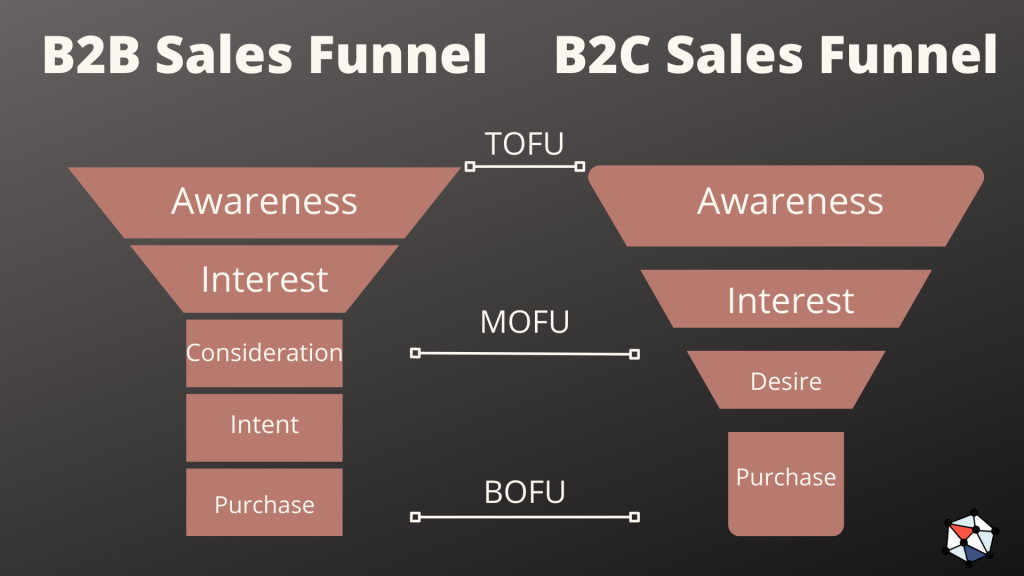
Awareness is key to a successful B2B sales funnel; that’s why companies in the respective industries invest in strategies that would help a prospect to learn more about the product. Such strategies often include:
- Free trials and product demos (typical for SaaS marketing)
- Webinars
- Blog content
However, it doesn’t mean that you should direct all your SEO efforts only on the awareness stage. For B2B lead generation to succeed, a company should be present in the search results for every stage of the sales funnel.
In other words, if a prospect has read several of your blog posts, seen a product landing page, and now wants to get a free trial, there should be a query in SERPs that will take them to a respective page on your website.
So, as a B2B marketer, you have to know your buyer persona to the tee. With B2C SEO, things are not as strict, where a purchase can be made within a single session.
Difference #2: Keyword strategy
Here, the main difference lies in the keyword volume.
Essentially, B2C companies target high-volume keywords because they aim to reach out to a bigger audience. Here’s an example of the keywords FashionNova, a popular e-commerce website, is ranking for:
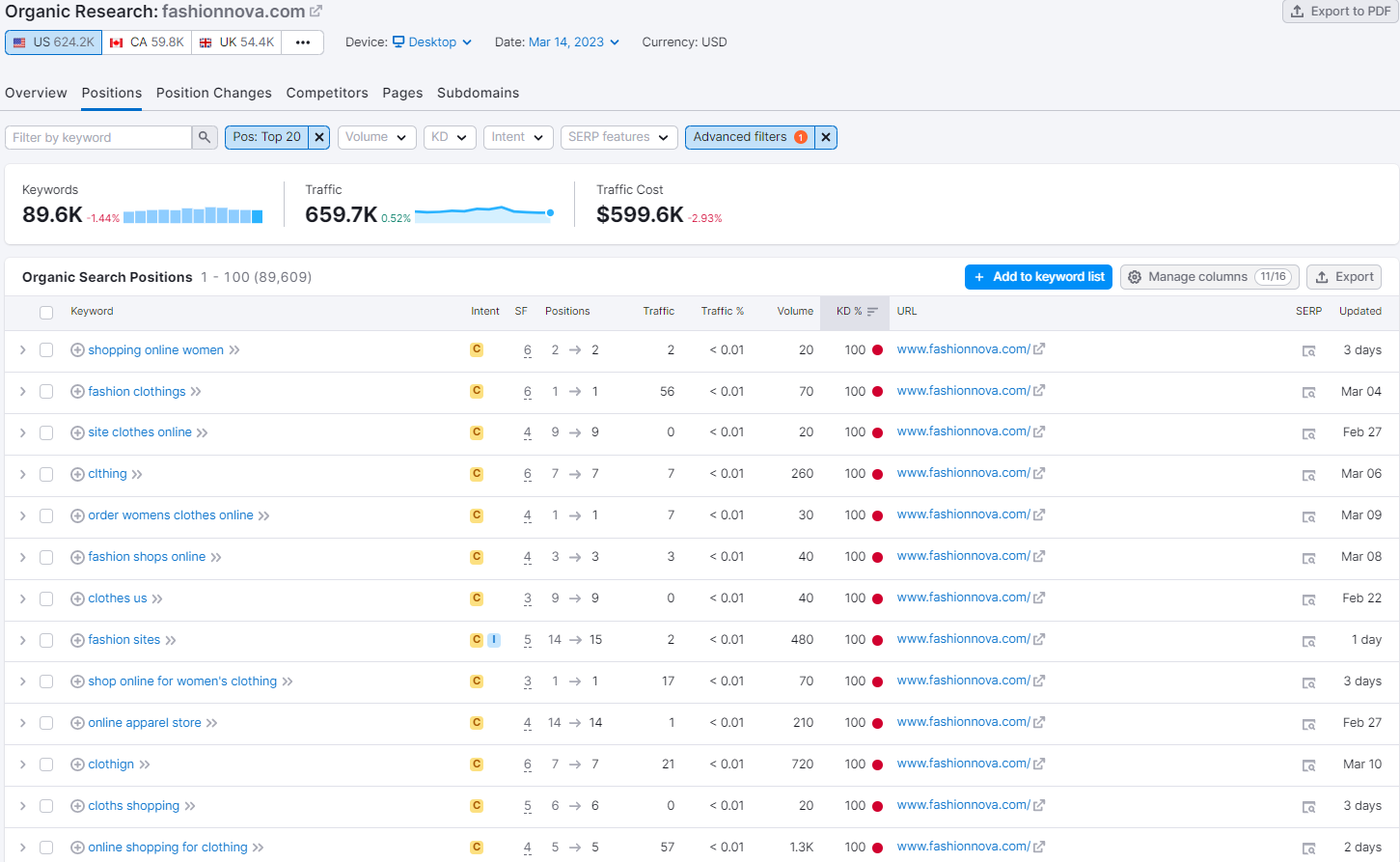
As you can see, the company targets many relevant keywords with high monthly search and significant keyword difficulty. This approach allows them to reach more potential customers and drive more traffic. By the way, this method is also among the most popular Etsy SEO tips, and you might find it helpful if you sell your products there.
Conversely, B2B businesses focus on low-volume, long-tail keywords. This way, you have a chance to target niche topics your audience is interested in, and your competitors haven’t covered yet.
Take, for instance, Indoorway, a company with a solution that collects, tracks, and analyzes data for manufacturing companies. If we review its website in Semrush, you’ll see that it targets lower volume keywords compared to the example above:
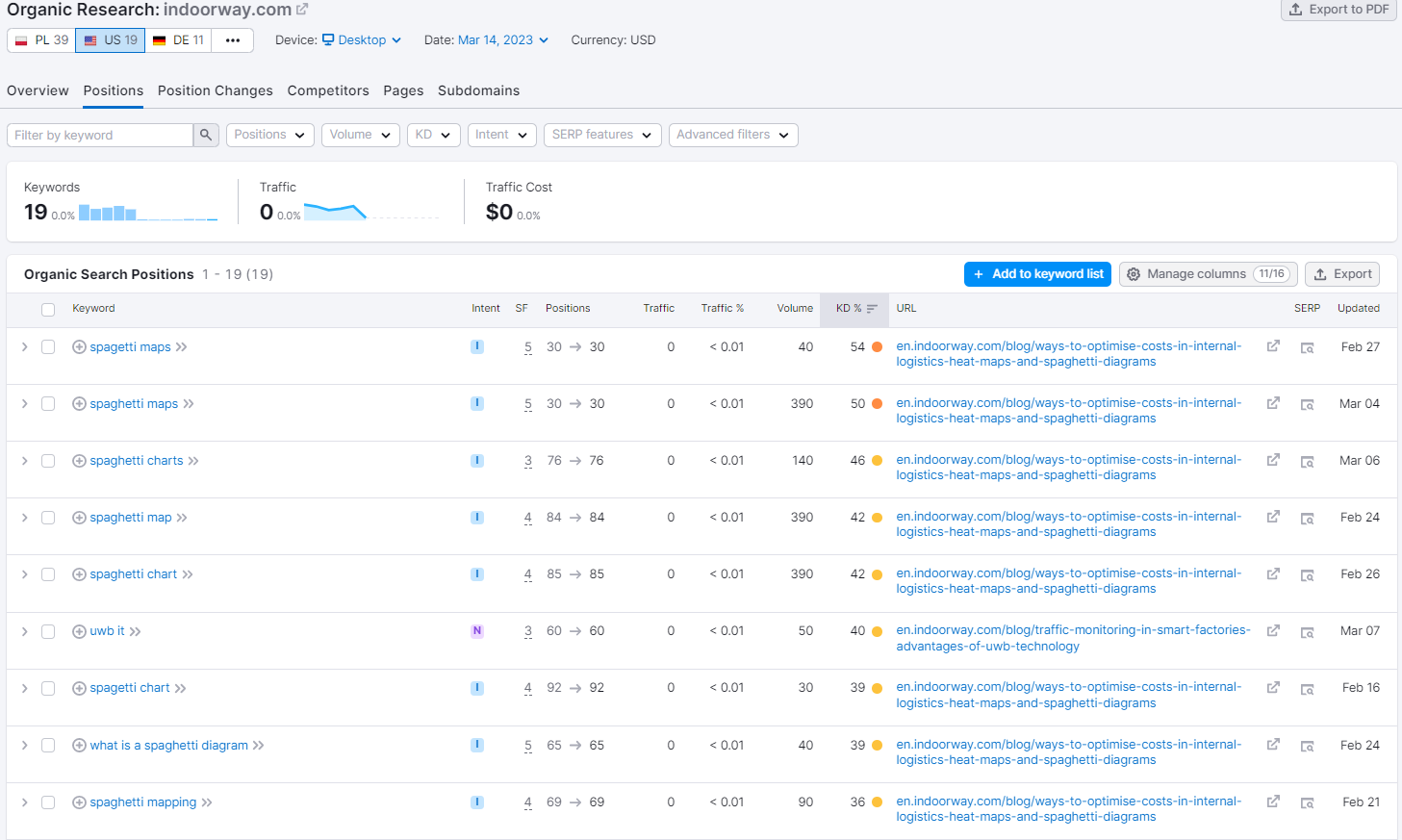
The reason is simple – Indoorway wants to target people within a specific niche; that’s why it doesn’t make sense for the company to target different keywords of a broader spectrum. This is a difficult job to do since you need to know your target audience inside out to do B2B keyword research properly. You might also want to include your CRM, such as HubSpot, to study your buyers’ behaviors.
Difference #3: Link building
Link building is one of the core strategies in SEO, but it also has its differences in B2B and B2C, chiefly because they target different audiences.
Here are some aspects that define link building in B2B:
- The focus goes on educating the audience. So, the main purpose of a backlink in B2B is to provide value and share helpful information about a product.
- Backlinks are often acquired through authoritative content. B2B websites often use infographics, original research, white papers, and case studies to generate backlinks.
- Link building is relationship-based. Oftentimes, B2B ventures build partnership networks within which they exchange links. One of such networks is B2B Bloggers Boost Group on Facebook, where you can find guest posting opportunities to build links. Similar communities can be found on LinkedIn.
Now, let’s hover over to B2C link building to single out the differences:
- Social media is the main focus. B2C companies often put the most effort into optimizing links for primary social networks such as Instagram, Facebook, and Twitter. These platforms are where most of the B2C audience often comes from.
- Fewer links are needed to show the result. Compared to B2B, B2C companies don’t have to build as many links. The main goal is traffic.
- B2C often uses brand affiliation for link building. Through this approach, B2C brands manage to grow their reach as well.
So, let’s sum up.
There is no particular difference between B2B and B2C link building when it comes to goals. However, a few factors come into play to achieve these goals.
B2B link building focuses more on creating educational prospects to persuade the audience to buy a product. In its turn, the process of building links for B2C is more oriented towards reach and faster conversion.
As you now have a clearer understanding of the contrast between B2B and B2C SEO, let’s discuss the process of building an efficient B2B SEO strategy.
How to Create a Successful B2B SEO Strategy
Of course, the scope of search engine optimization is so big that it’s impossible to cover it within one article. However, we’ll try to cover the basics to help you get a clear understanding of what it takes to build a working B2B SEO strategy.
Let’s dive in.
Step #1: Conduct keyword research
Keyword research is the backbone of SEO. As we mentioned in the previous section, B2B marketers should focus on low-volume keywords since they usually target a very niche audience. But there are a few more peculiarities of doing keyword research for B2B search engine optimization.
Here are some steps that will help you build the primary keyword list:
- Study your niche. You need to know what your target audience discusses online, so this is your way of getting to know them. One trick you can have up your sleeve is browsing forums like Reddit and Quora. For instance, let’s say you own a surveillance equipment company. To track topics relevant to your niche, all you have to do is type in the related query and browse through the discussions:
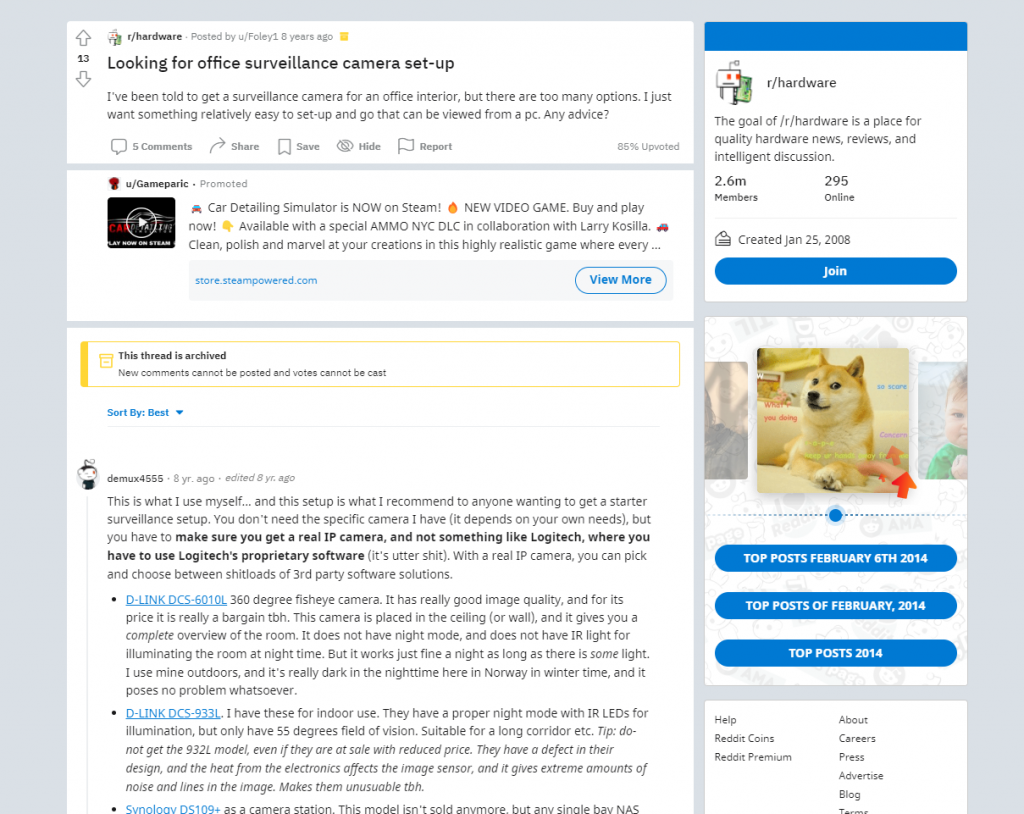
- Identify seed keywords. Once you have a more or less clear understanding of your niche, you can put together the list of seed or short-tail keywords. This list will also make it easier to look for long-tail keywords later on. To illustrate, let’s take our surveillance camera keyword and type it into Semrush. As you can see, the keyword itself is very competitive, but there are a few low-competition queries you can add to your list of long-tail keywords:
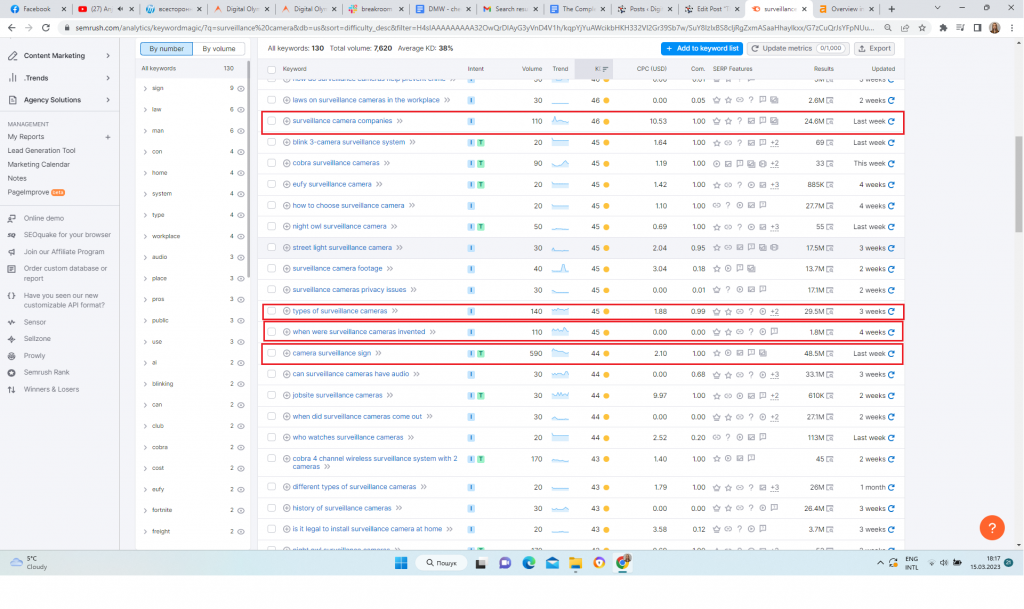
- Research your competitors. Targeting the same keywords as your rivals is completely normal. Moreover, it can supply you with endless content creation ideas and options to outrank competing websites in SERPs. Besides, it’s very easy to do. In Semrush, just type in the keyword, scroll down to SERP Analysis, look for competing websites and click on URL keywords – it will give you the list of all organic search positions the page ranks for:
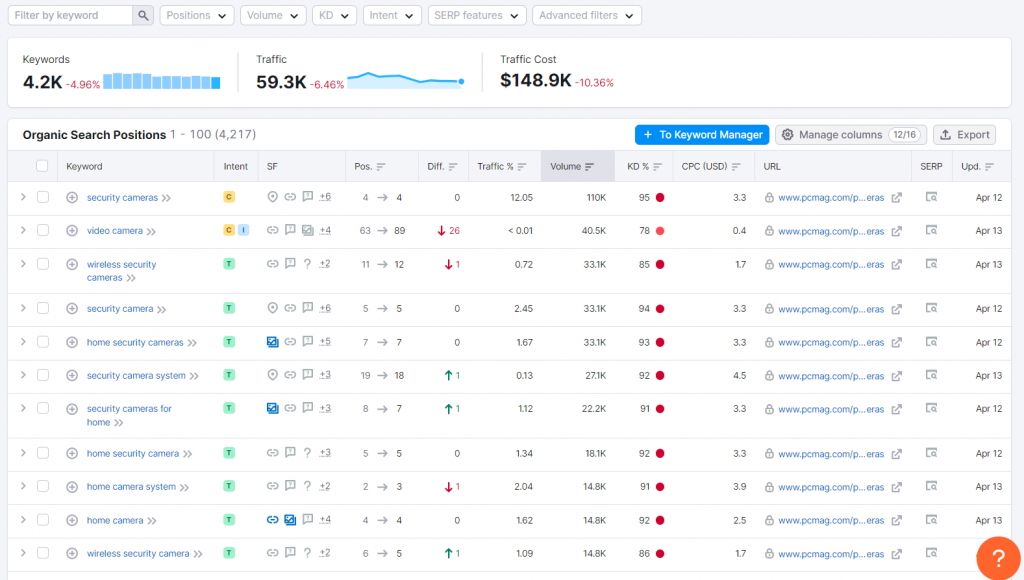
If you’re not a fan of Semrush, Ahrefs works according to the same principle.
Employing these strategies will help you conduct keyword research in a comprehensive way and build a list of topics for your B2B copywriters to create high-quality content, which will be used at different sales cycle stages. Let’s cover this aspect in more detail in the next section.
Step #2: Find top-of-the-funnel topics
If you scroll back to our sales funnel graph, you’ll see the term TOFU (top of the funnel). This is the point where you introduce the leads to the product, in other words, educate them about what it can do. You can learn more about different sales funnel stages in our lead generation article.
Top-of-the-funnel keywords don’t bring you an immediate sale, but they play an important role in building up conversion rates. Essentially, the content strategy you create using these keywords serves to convince the prospect that they need your product. Besides, such keywords have a bigger search volume.
If you circle back to our surveillance camera keyword and go through the results, you’ll see many search queries with informational search intent. That’s what we need to create the list of TOFU keywords.
You can also browse through the related questions (also with informational intent) – the example below shows that you can generate quite a few great blog post topics from this list, and most of the long-tail keywords are not as competitive:
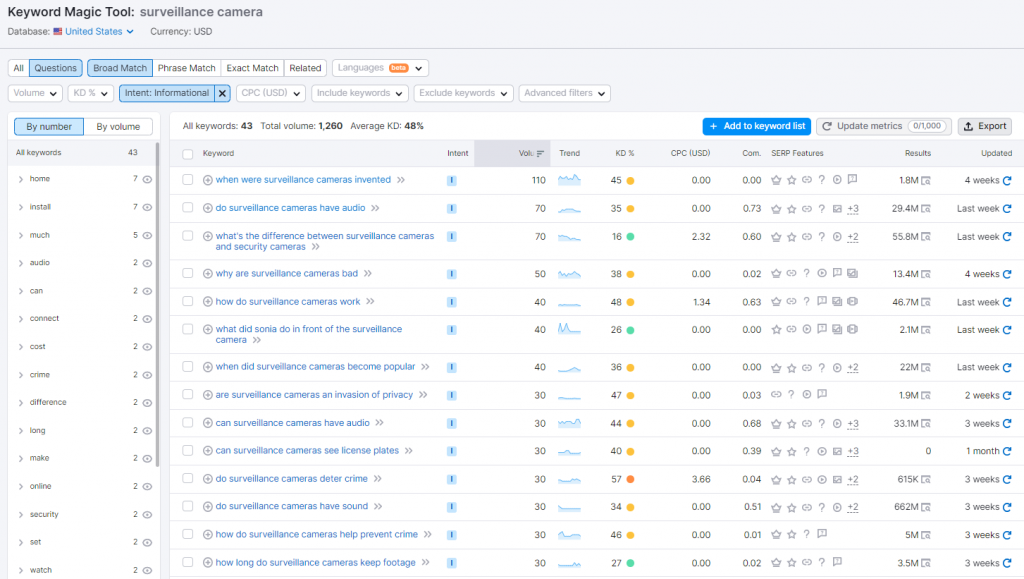
You can also take advantage of queries with commercial investigation intent and use them to create analytical articles highlighting the pros and cons of a product. The keyword below has low competition but a pretty high search volume if you take a closer look at the metrics:
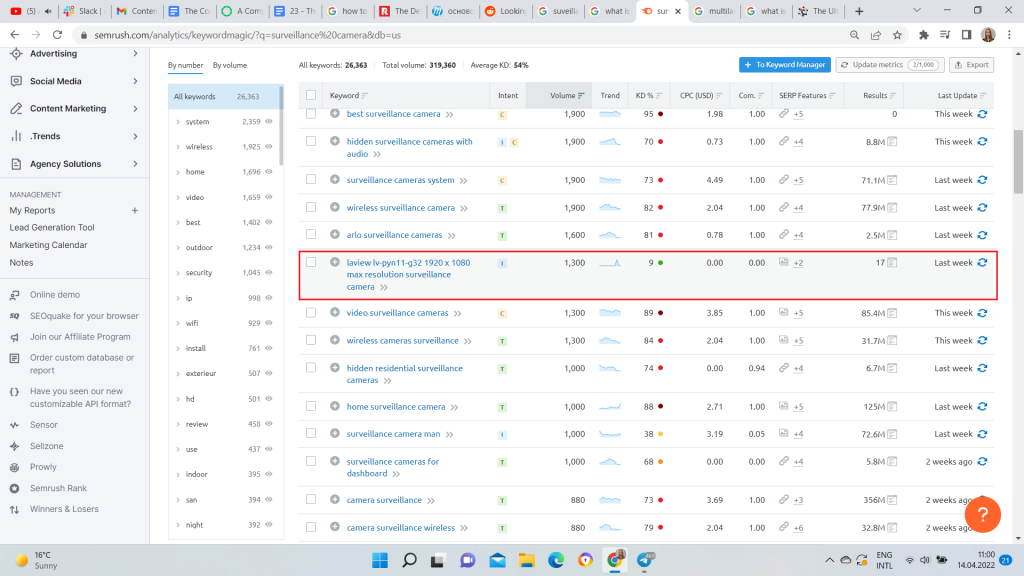
If you click on this keyword, you’ll see the list of web pages ranking for it. You can go through other search terms they include, analyze what these pages lack, write a more comprehensive piece of content on the same query and try to outrank them.
Once you have the list of TOFU keywords, you can look for middle-of-the-funnel (MOFU) and bottom-of-the-funnel (BOFU) queries that usually pursue a commercial intent. But to make sure your SEO strategy works, you also need to perform on-page optimization. Let’s talk about it in the next section.
Step #3: Perform on-page optimizations
On-page SEO refers to all the strategies involved in making changes to a page that can improve its performance in search engines. The opposite to it is off-page SEO, which includes actions outside of the page to improve its rankings.
One of the measures included in on-page SEO is the optimization of the meta tags, which include:
- Title tag – a title unique to every page on your website.
- Meta description – a short description of the content on each page.
- Viewport tag – responsible for how your page shows on mobile devices.
- Robots – indicate if the content should be “dofollow”, “nofollow”, “index”, or “noindex”.
- Canonical tags – point out the primary or principal versions of a page.
Among these indicators, also known as HTML tags, the key role plays the title tag and meta description. These are optimized via CMS like WordPress and its alternatives. In WordPress, admins often use plugins such as Yoast SEO:
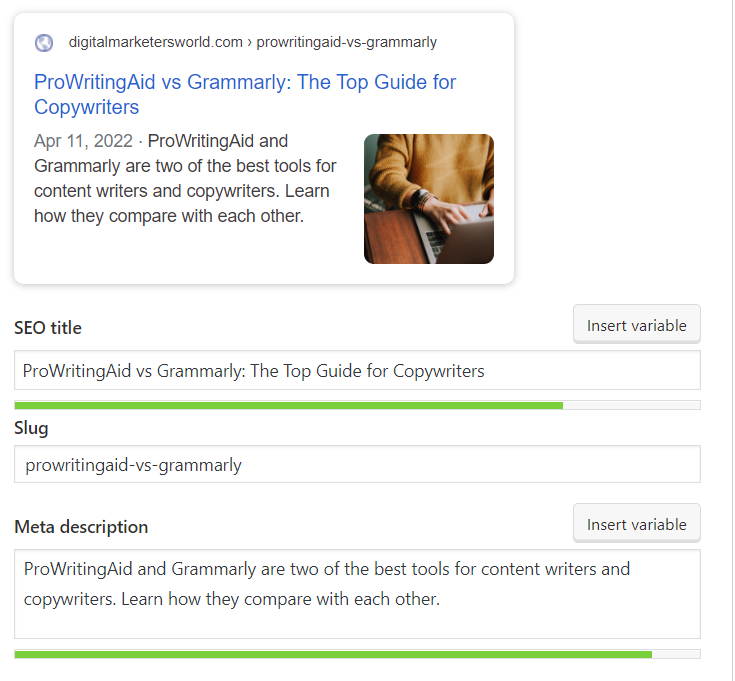
Using such plugins is very convenient as they guide you to the optimal number of characters both for the meta title and meta description to make sure they show properly on Google. Optimizing other meta tags often requires extensive knowledge of technical SEO, so it’s always a good idea to include an SEO professional in your team to cover these tasks or hire SEO services.
Now, let’s get to the next step.
Step #4: Build topic clusters
Content clusters create the hierarchy of pages that belong to the same group. Creating such clusters also builds a framework of internal links, which helps visitors and Google algorithm navigate your website faster.
Topic clusters are essential if you have several content pages under the same category or an extensive guide with several chapters, like in the example of Viral Loops below:
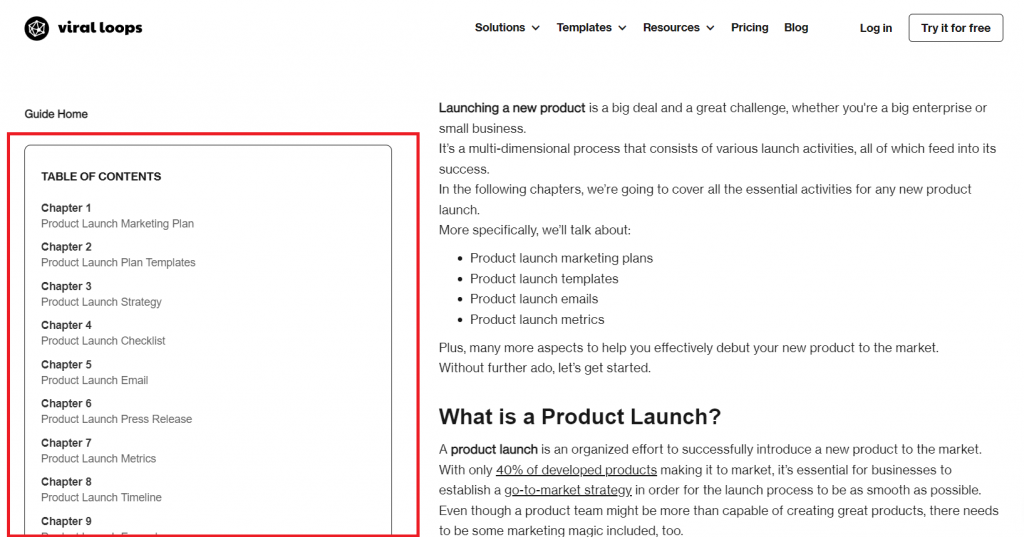
The main page of this guide is a pillar page, while all the chapters are cluster pages. Such hierarchy also impacts page URLs which end up looking like this:

How does it help SEO?
Apart from improved user experience, creating a page hierarchy with clusters encourages the visitors to stick around on your website. They see how much they can learn from your blog and how easy it is to navigate all the topics, so they will gladly stay and learn more. By building clusters, you follow a content marketing trend of making your content user-oriented and increase the click-through rate, as a result.
The same goes for search engines. Having an extensive hierarchy of topics shows a crawler bot that your website is an authoritative resource. Besides, since content clusters encourage visitors to stay on certain pages longer, extending session length (and decreasing the bounce rate), this is also a good factor for your website’s performance.
Step #5: Build backlinks
Content marketing is one of the most reliable ways of building links for B2B brands. Besides, earning backlinks is one of the crucial ranking factors B2B SEO managers should take into account.
But how can you know how many links you should build to a web page to help it rank higher in Google search?
This is impossible to do manually, so you’ll have to equip yourself with marketing automation and SEO tools. In this case, Ahrefs is the best option.
Essentially, what you need to determine is the link gap – the difference in referring domains that your page has vs. the number that your competitors have built.
To calculate this gap, you need to go to the Batch Analysis report in Ahrefs and enter several URLs, including your own and your competitors’. The result will show you the number of referring domains you and your rivals have, and you can calculate the link gap by subtracting your amount from the competitor’s amount:

You can also use Ahrefs to determine the referring domains linking back to your rival’s web page. However, you should also watch out for the website’s DR, where you’re trying to get a backlink. Also, keep an eye on the number of referring domains linking back to your competitor’s page. If it becomes higher than yours, you’ll have to keep building links to close the gap. It’s also essential to monitor the performance of your pages via Google Analytics and search console.
So, link building is definitely an ongoing process, not a one-time activity. If you’re not sure you can handle outreach and other involved tasks on your own, it’s better to hire someone to help you. In case you’re new to this strategy, we recommend checking out our article covering the seven best link building agencies, where you can learn more about how they can help you.
Over to You
We’re not going to deny it – SEO work, multifaceted process, and B2B SEO has its peculiarities. Nevertheless, you can’t skip it if you want to get more clients and grow your online presence.
Let’s quickly recap all the steps necessary to build a B2B SEO strategy:
- Conduct detailed keyword research.
- Collect top-of-the-funnel keywords.
- Do on-page optimizations consistently.
- Build topic clusters.
- Invest in link building.
Of course, one article is not enough to cover such an extensive topic, but we promise to deliver more guides in the future. Meanwhile, we invite you to check out other posts on digital marketing on our blog!

Mariia is a content strategist and editor at Digital Marketer’s World. She is passionate about educating others on all things marketing and believes in the power of the written word.
